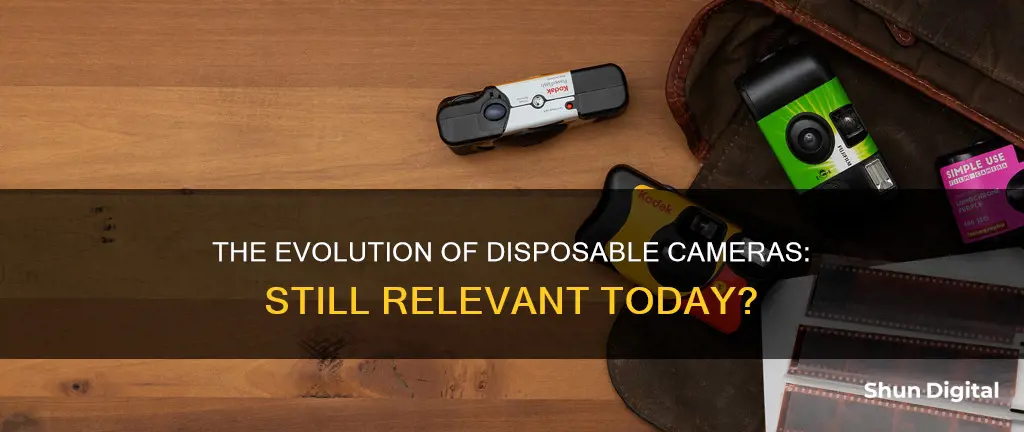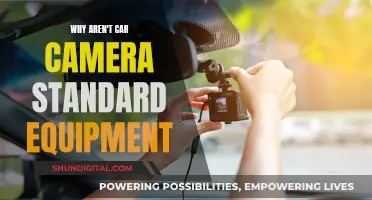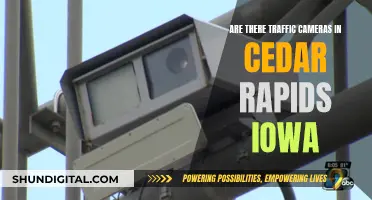
Disposable cameras are still sold in many places, including big chain retailers like Walmart, Target, and Walgreens. They are also available online on Amazon and eBay. Despite the advent of smartphones and other devices with built-in cameras, disposable cameras remain popular for several reasons. They offer a unique, authentic experience with a sense of nostalgia, providing physical prints that can be hung up or kept in a scrapbook. The delayed gratification of not seeing photos immediately adds an element of surprise and anticipation. Disposable cameras are also affordable, accessible, and perfect for parties or weddings, often sold in multipacks. They are easy to use, with a simple point-and-shoot mechanism, and come with a flash for low-light conditions. Additionally, disposable cameras provide a break from constant technology use and can be a fun way to start exploring film photography.
| Characteristics | Values |
|---|---|
| Use cases | Special events, underwater photography, art, sailing, kids' parties, travel |
| Pros | Tangible end result, delayed gratification, unplugging from technology, affordability, accessibility, unique aesthetic, anticipation, nostalgia, ease of use |
| Cons | Environmental impact, low image quality, limited exposures, no preview, washed-out photos, inconvenience |
| Brands | Kodak, Fujifilm, Ilford, Lomography, Harman, Analog Camera Company |
What You'll Learn

The unique aesthetic and imperfections
The unique aesthetic of disposable cameras is characterised by a grainy, slightly blurred, and washed-out quality that evokes a vintage and nostalgic feel. This aesthetic is highly sought-after, with people trying to replicate it on their digital photos using filters and editing techniques. The images produced by disposable cameras have a softer look due to the use of plastic lenses and film tuned to work best in midday sunlight, resulting in colour shifts when used with artificial light sources.
The imperfections of disposable cameras, such as light leaks and overexposure, add character and personality to the photos. These imperfections can create interesting and artistic effects that cannot be achieved with digital editing. Embracing these imperfections is key to the disposable camera aesthetic, as it is the lack of precision that gives the photos their unique charm.
The limitations of disposable cameras, such as the small number of shots and the lack of a screen, encourage users to be more selective and intentional with their shots, resulting in more meaningful and candid images. The anticipation of waiting for the film to be developed adds to the excitement and surprise of using disposable cameras.
Disposable cameras provide a break from the constant stimulation of technology, allowing users to be fully immersed in the experience of taking photos and capturing memories. The physical act of winding the wheel and the satisfying click of the shutter button contribute to the overall experience and fun of using disposable cameras.
Fujifilm Camera: Converting RAW to JPEG Simplified
You may want to see also

The element of surprise and anticipation
Disposable cameras offer a unique experience of surprise and anticipation that is often missing in the digital age of instant gratification. Unlike digital cameras and smartphones, which allow us to preview and delete photos instantly, disposable cameras create an air of mystery and excitement as we wait for the film to be developed.
The anticipation of waiting for photos to be developed adds an extra layer of excitement and surprise. We don't know exactly how the photos will turn out, leading to unexpected and unique shots that capture the essence of our family and friends. This sense of surprise and mystery is enhanced by the limitations of disposable cameras, such as light leaks, exposure issues, and focus and framing challenges, which can create interesting and artistic effects.
Disposable cameras also offer a break from the constant stimulation of technology. Without screens, filters, and editing tools, we are forced to be more mindful and selective with our shots, creating a more authentic and genuine representation of the moment. The limited exposures available on disposable cameras further encourage thoughtful composition and add to the charm of film photography, where every shot is valuable.
In a world dominated by digital photography, disposable cameras provide a refreshing change of pace and a nod to simpler times. They invite us to embrace the unexpected and celebrate the joy of anticipation. Whether it's for a special occasion or everyday moments, disposable cameras offer a unique way to capture life's moments and remind us of the beauty of unplanned, unedited snapshots.
Understanding Camera Raw: The 'A' Mystery Explained
You may want to see also

Affordability and accessibility
The affordability and accessibility of disposable cameras have contributed to their resurgence. With digital cameras and smartphones becoming more expensive, disposable cameras offer a budget-friendly alternative for capturing memories. They are widely available at pharmacies, supermarkets, and online retailers, making them easily accessible to anyone who wants to try them out.
Disposable cameras are also a great option for those who want to get into film photography without shelling out a lot of money for a camera. They are perfect for family outings, vacations, and outdoor activities due to their compact shape and ease of use for both pro and amateur photographers. Additionally, they are long-lasting and frequently available in great-value multipacks, making them a fun addition to ceremonies or parties.
The low cost of disposable cameras is due to the simple materials used in their construction, such as plastic, paper, cardboard, and steel. This also makes them lightweight and compact, ideal for travel and nature enthusiasts who want a small, relatively unbreakable camera that doesn't require recharging.
While the cost per image of film photography is relatively high, disposable cameras keep the expense to a minimum, with some options available for under $0.60 per frame before processing costs. For example, the Fujifilm QuickSnap Flash 400 and Kodak FunSaver, two of the most well-known disposable cameras, are available for $26.
Lightroom and Camera Raw: What's the Difference?
You may want to see also

Environmental impact
Disposable cameras have faced criticism for their negative environmental impact. When they were first introduced in 1987, they were branded as wasteful, with consumers demanding to know where the cameras would end up after being used and discarded. Indeed, the original disposable cameras were sonically welded together, requiring them to be destroyed to extract the film, and the plastic parts often ended up in landfills. This led to a backlash from environmental organisations and government officials, with Kodak mockingly receiving a "Waste Maker of the Year" award from a US senator in 1989.
In response to the criticism, Kodak and Fuji introduced recycling programs in 1989 and 1990, respectively. These programs incentivised photofinishers to return the cameras they developed to the manufacturer for recycling. The cameras were disassembled, and parts such as plastic bodies, flash circuits, and batteries were reused or recycled. Kodak's recycling program was particularly successful, with 86% of the successor to the FunSaver, the Kodak Max, being made from reclaimed parts. Additionally, the plastic bodies of the cameras could be reused up to six times, and the flash circuits up to ten times.
Today, it is more accurate to view disposable cameras as recyclable rather than disposable. The cameras are manufactured with a modular design, making it easy to remove and recycle assemblies like the flash, lenses, and viewfinders. The plastic bodies are crushed, melted, and remoulded, and the salvaged components are reassembled into complete cameras. As a result, very little waste is generated. In Europe, the recycling and disposal of disposable cameras are covered by the EU's directive on waste electronic equipment.
Switching Up S7 Camera Modes: A Guide
You may want to see also

Where to buy
Disposable cameras are available at a variety of retailers, both online and in physical stores. Here are some places where you can buy disposable cameras:
Online Retailers
- Amazon: Amazon offers a wide range of disposable cameras from brands like Fujifilm and Kodak. They have various pack sizes available, including single packs, double packs, and larger packs of up to 8 cameras. Prices vary depending on the brand and pack size, but they generally range from around $20 to $140.
- EBay: eBay is another online option for purchasing disposable cameras. While some cameras may be sold individually, eBay is a good place to find bulk options and deals on multiple packs.
- B&H Photo Video: B&H is a reliable retailer that offers disposable cameras, and their website makes it easy to compare different brands and models.
- Adorama: Adorama is another trusted retailer that carries disposable cameras, and they often have sales and promotions.
- Richard Photo Lab: This website offers disposable cameras starting at $8.99, with options for Kodak and Fujifilm brands.
Physical Stores
- Walmart: Walmart carries a range of disposable cameras, including options from Kodak, Fujifilm, and their own Walmart brand. Prices start as low as $10, making it a cost-effective option.
- Target: Target also offers disposable cameras, though their selection may vary by store. It's best to check their website or your local store for availability.
- Urban Outfitters: If you're specifically looking for the Fujifilm QuickSnap Flash 400 or the Kodak FunSaver, Urban Outfitters carries these models for $26 each.
- Local Drugstores and Convenience Stores: Disposable cameras are often available at local drugstores, convenience stores, and even airport shops. However, the selection may be limited to popular brands like Fujifilm and Kodak.
When purchasing disposable cameras, it's a good idea to check the expiration date and ensure the packaging is in good condition, especially if you're buying from a physical store. Proper storage and handling are important to ensure the film inside the camera is not damaged or degraded.
Battery Life of Wireless Security Cameras: How Long?
You may want to see also
Frequently asked questions
Yes, disposable cameras are still being manufactured and are easily available at pharmacies, supermarkets, and online retailers.
Disposable cameras offer a unique experience with their delayed gratification, physical prints, and vintage aesthetic. They are also affordable, accessible, and perfect for special events.
Kodak and Fujifilm are two well-known brands that make disposable cameras. Ilford, Lomography, and Harman also offer disposable cameras with unique features.
Disposable cameras can be found at major retailers like Walmart, Target, and Walgreens, as well as online stores.
Disposable cameras are great for weddings, parties, vacations, and outdoor events. They can be handed out to guests or used personally, adding an element of surprise and fun to the occasion.







